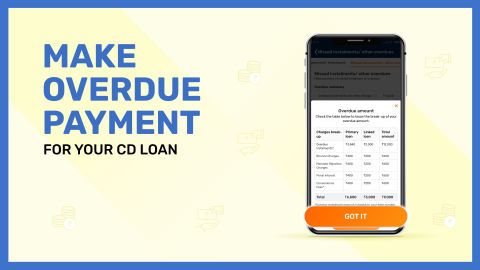What causes ECS returns in medical equipment loan?
An ECS (Electronic Clearing Service) return occurs when an automated EMI deduction fails from the borrower’s bank account. For medical equipment loans, this can lead to service disruptions, penalties, and even impact credit scores. Understanding the reasons behind ECS returns is essential to avoid financial complications during an already sensitive time—when access to medical equipment is critical. Here's a breakdown of common causes:1. Insufficient balance in account
The most common cause of an ECS return is a lack of sufficient funds in the bank account at the time of EMI deduction. Even a shortfall of a few rupees can result in a failed transaction, triggering return charges and possibly a late fee on the loan.2. Technical errors or network issues
Sometimes, ECS returns are caused by technical glitches such as system outages, delayed settlement processing, or bank-side errors. Although less common, these can still result in charges unless resolved promptly.3. Incorrect account details
If the ECS mandate contains incorrect account information—such as a wrong account number, IFSC code, or mismatched account holder name—the transaction will fail. This is often the case when the mandate is not set up correctly at the start of the loan.4. Expired or revoked mandate
An ECS mandate is typically valid for the duration of the loan, but it may become inactive if the borrower revokes it or the bank deactivates it due to inactivity. In such cases, future ECS deductions will be returned.5. Account closure or freeze
If the borrower’s bank account has been closed, frozen, or flagged for suspicious activity, ECS debits will not be processed. This is especially problematic if the borrower is unaware of the account status.6. Exceeding debit limits
Certain accounts, especially savings accounts, may have daily or monthly debit limits. If an EMI exceeds this limit, the ECS will bounce.Avoiding ECS returns involves careful financial planning, timely fund deposits, and regular monitoring of your loan and bank account status.
How medical equipment loan ECS return charges are calculated?
ECS return charges are penalty fees levied when your EMI payment through ECS fails. These charges vary depending on your bank, lender, and frequency of missed payments. Here's how they are generally calculated and what you need to know:Key points on calculation of ECS return charges:
Flat fee per return: Most banks charge a flat fee per failed ECS transaction, usually between ₹200 and ₹750.Lender-specific penalties: In addition to your bank, your loan provider may impose its own penalty or late payment fee.
GST applicable: Return charges are often subject to 18% GST, increasing the total payable.
Multiple failures multiply charges: Each failed attempt (if your ECS is retried) may incur separate charges.
Added late payment fees: If the EMI is not paid promptly after the ECS bounce, a daily or monthly late fee may be added by the lender.
Interest on overdue amount: Some lenders also add interest on the unpaid EMI amount until it's cleared.
Common reasons for ECS returns
Insufficient balance: The most common reason—if there aren’t enough funds at the time of ECS debit.Incorrect account details: Mistakes in account number, IFSC code, or account holder’s name.
Revoked or expired ECS mandate: An inactive or withdrawn mandate cannot process debits.
Technical failures: Issues in the bank’s system or payment gateway during processing.
Account closure or freeze: A closed or temporarily frozen account will result in transaction failure.
Exceeded debit limit: If your account has daily/monthly debit limits and EMI exceeds them.
Dormant account: If the account hasn’t had recent activity, banks may block ECS transactions.
How to avoid ECS return charges on your medical equipment loan?
Maintain sufficient balance: Ensure your account has enough funds a day before the EMI date.Set payment reminders: Use calendar alerts or mobile apps to track your EMI dates.
Keep account active: Avoid long inactivity periods to prevent dormancy.
Double-check ECS mandate: Ensure the account number and IFSC details are accurate.
Enable SMS/Email Alerts: Opt for transaction alerts to monitor ECS status in real-time.
Talk to your lender: If facing financial trouble, discuss temporary deferment options to avoid penalties.
Use auto recharge wallets (if applicable): Some NBFCs offer wallet features that auto-refill for EMI payments.
Regularly review bank limits: Ensure your account allows the necessary EMI amount within debit limits.
By staying proactive and informed, you can avoid ECS return charges and ensure a smooth repayment experience for your medical equipment loan.
How to resolve ECS returns on your medical equipment loan?
ECS returns can disrupt the repayment process for your medical equipment loan, leading to penalties and delays. If your ECS transaction has failed, it's important to act quickly to resolve the issue and prevent further complications. Here are steps to resolve ECS returns:Contact your bank for solutions
Reach out to customer support: If you notice an ECS return, contact your bank immediately. Their customer service team can explain the reason for the failure and guide you through the process of rectifying the issue.Request transaction details: Ask for transaction specifics, including the reason for failure (e.g., insufficient funds, incorrect details, etc.), so you can address the exact cause.
Inquire about fees: Check if any ECS return charges have been levied and request a waiver or reduction if you believe the issue was caused by an error on the bank’s part.
Verify ECS mandate status: Confirm that the ECS mandate is still active, and request assistance if it needs to be reactivated or corrected.
Confirm bank policies: Ask about the bank’s policy on retries for ECS payments. Some banks will attempt to re-debit the EMI after a certain period or charge a reduced fee for subsequent attempts.
Correcting insufficient funds or account details
Ensure sufficient balance in your account: If the ECS failed due to insufficient funds, deposit the required amount as soon as possible. This ensures that your next payment attempt is successful.Set up automatic transfers: To avoid insufficient funds in the future, consider setting up an automatic transfer to ensure your account has adequate balance before the ECS debit.
Check and update account details: If your account details were incorrect, verify your bank account number, IFSC code, and other details to ensure they match your lender's records.
Update your ECS mandate: If your account details changed (e.g., switched to a new bank or changed account type), inform your lender and update your ECS mandate with the new information to avoid future payment failures.
Review your loan schedule: If you are facing difficulty in maintaining sufficient balance, contact your lender for options like a loan rescheduling or EMI deferment.
By taking prompt action and addressing the root cause of the ECS return, you can avoid further charges, ensure smoother loan repayments, and keep your medical equipment loan on track.
Legal implications of ECS return charges
ECS (Electronic Clearing Service) return charges may seem like a simple penalty, but they can have significant legal implications if not addressed properly. If your medical equipment loan ECS returns frequently or remains unresolved, it could lead to complications beyond just financial penalties. Here's a breakdown of the potential legal impacts of ECS return charges:1. Impact on credit score
Late payment records: Unpaid ECS payments are often reported to credit bureaus, which could affect your credit score negatively.Loan eligibility: A low credit score can reduce your chances of securing future loans or credit facilities, including medical equipment financing.
Long-term effects: Multiple ECS failures can lead to prolonged damage to your credit profile, which can take months or even years to repair.
2. Legal action for loan default
Loan default clause activation: If the ECS return charges are not paid promptly, your lender may consider you in default of the loan agreement.Collection efforts: Lenders may begin aggressive collection efforts, including phone calls, emails, or even legal notices demanding immediate repayment.
Court action: If ECS returns continue without resolution, the lender may initiate legal proceedings to recover the loan amount, which could involve court cases and additional legal fees.
3. Higher penalties and interest rates
Accumulation of charges: If you don’t clear your ECS return charges, they could accumulate over time, increasing the amount you owe. In some cases, lenders may apply a higher interest rate on outstanding dues.Additional fees: Legal fees, collection agency charges, or settlement costs may also be added to your overall loan balance, further escalating the financial burden.
4. Impact on future financial transactions
Blocked transactions: A poor repayment history due to ECS returns could cause issues in future financial dealings. You may face difficulties with opening new bank accounts or using other ECS payment modes, such as the ECS payment mode.Lender’s blacklist: If your ECS returns are unresolved, lenders might blacklist you, making it difficult to obtain financing in the future.
5. Legal framework governing ECS
Regulation by RBI: The Reserve Bank of India (RBI) provides guidelines on ECS transactions. Repeated returns may not only result in financial penalties but could also violate the terms outlined by the RBI.Dispute resolution: If there are genuine errors or discrepancies in the ECS return process, the customer has the legal right to dispute the charge with their bank or lender and seek resolution.
6. Steps to prevent legal consequences
Timely payments: Always ensure timely payment through the Bajaj Finance quick payment options to avoid ECS return charges.Communication with lender: If facing difficulties, contact your lender to discuss options such as loan restructuring or deferment to prevent legal action.
Understanding and addressing ECS returns promptly can prevent them from escalating into serious legal issues. By maintaining clear communication with your bank and lender, you can protect yourself from unwanted legal consequences.




